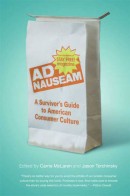Every Thursday on the blog brings a post about a paperback book. This might be a book originally published in hardcover or — as with this week’s subject — being published for the first time in paperback.
 In his sharp, brief foreword to Ad Nauseam: A Survivor’s Guide to American Consumer Culture
In his sharp, brief foreword to Ad Nauseam: A Survivor’s Guide to American Consumer Culture, Rob Walker writes:
It’s a sad fact that while the shaping of consumer culture is an incredibly important topic that touches all of our lives on many levels, the vast majority of commentary about it is written by a group of people whose opinions are decidedly skewed. These are the marketing professionals and gurus whose assessments of commercial persuasion in American life invariably boil down to Seven Tips for Selling More Whatever to today’s savvy consumer. Whatever value that sort of thing may have for the trade, it’s not very useful to the other participants in consumer culture: everybody else.
So, “everyone else” is the large target audience for this book. How to promote a book that is so deeply suspicious of promotion is a conundrum I will leave to its editors, Carrie McLaren and Jason Torchinsky. McLaren began a zine called Stay Free! in 1993. It hasn’t been printed on paper in a few years, but it’s still around online to “explore the politics and perversions of mass media and American (consumer) culture.” About 70 percent of this illustrated book has been culled from the magazine’s archives.
Given the rapid developments in advertising (and in the average person’s understanding of it), some of the pieces have aged better than others. When McLaren says of a job she had shilling for a record company, “I wasn’t being asked to advertise in Details because it’s well-written, informative, or interesting, but because it reaches and influences the right audience,” you’re not surprised to see an original run date of 1997. It’s not that the idea is wrong, but just so readily accepted now.
The editors are mostly smart and funny in describing how advertising’s ubiquity has turned us into “fish who can’t see the water,” though their complaints of the larger problem sometimes require a grain of salt. Their reasonable argument that profit shouldn’t drive every last element of a culture’s life can morph into its unreasonable opposite: that profit is inherently evil. And they’re occasionally so quick to take an “everything’s getting worse” stance that they will ignore the facts, and even tell us they’re doing it. (As in a bogus stat about teenagers in the ’50s having twice the vocabulary of teenagers in the ’90s. McLaren writes: “Now, there’s no actual basis for this claim, but for the sake of argument, let’s say I believe it. The question, of course, is why the drop.”)
As it moves past a general critique of mass persuasion, the collection benefits from the steady inclusion of outside voices, often in the form of direct Q&As: A law professor discusses the commodification of the justice system. (“I’m not against sensorial buzzes, but I wouldn’t want to have someone’s life in a capital murder case depend upon it.”) There is a hilarious (and deeply sad) interview with a grown man who’s obsessed with Ariel from The Little Mermaid and all of her attendant merchandise. (“I couldn’t care less about mermaids. Ariel being a mermaid is just a coincidence.”) And a lively, antagonistic conversation takes place between Sut Jhally, a Marxist critic of advertising as a top-down enterprise, and James Twitchell, who focuses on the way that consumers “actively collaborat[e]” in the process.
Ad Nauseam is a witty, well-designed read. I might just complement it with something that takes an equally smart but less skeptical look at the craft of advertising, what Twitchell touches upon when he says: “Like the audience observing the magician, we know the lady is not being sawed in half. We can’t quite understand how it works, but we suspend disbelief and give ourselves over to it.”

